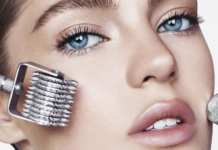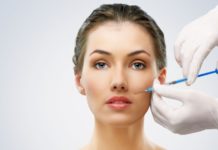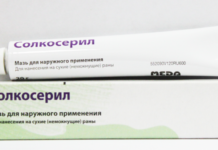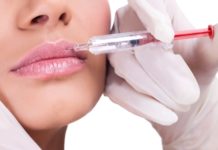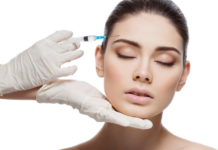Since the time of Avicenna, mankind has known about the healing properties of cold. As a result of the development of medicine, treatment with exposure to low temperatures stood out in a separate physiotherapeutic direction. It was called "cryotherapy", and today it is successfully used as an auxiliary method of treatment of many diseases. The essence and options for using this method will be discussed in the material.
Material Content:
What is cryotherapy?
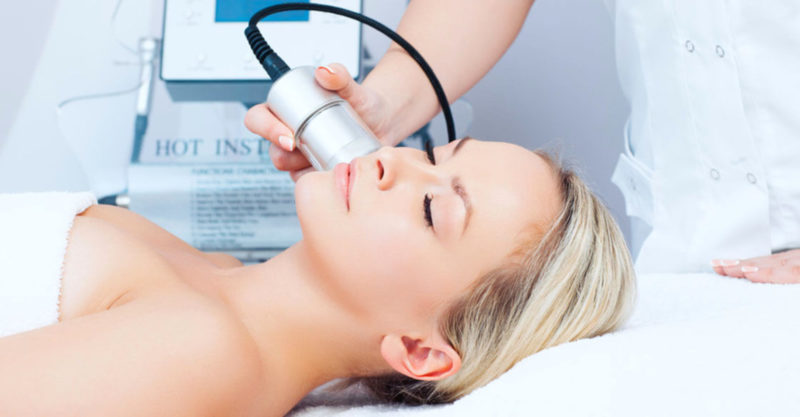
Cryotherapy is the common name for a number of physiotherapeutic procedures. They can be used both locally and in relation to the whole organism. Depending on the purpose of therapy, different devices and refrigerants are used - from ice applications to liquid nitrogen.
Indications and contraindications for cryotherapy are still being studied, but now the list of diseases for which cold treatment is used is quite impressive:
- In surgical practice: for the treatment of burns, wounds, ulcers, bedsores, erysipelas.
- In neurological practice: in the complex treatment of neuralgia, migraines, spastic hemiparesis, paraparesis, vertebrogenic pain syndromes, multiple sclerosis.
- In traumatology and orthopedics: treatment of injuries and pathologies of tendons, ligaments, soft and bone tissues, joints, contractures after prolonged immobilization.
- In rheumatology: for the treatment of arthritis, osteoarthritis, rheumatic lesions of the soft tissues.
- In cosmetology and dermatology: for the treatment of skin inflammations, acne, seborrhea, psoriasis, atopic dermatitis.
Cold therapy is included in the restoration programs of an aesthetic profile, it is successfully used to treat cellulite and correct excess weight.
As a result of cryotherapy, the following effects are achieved:
- Hemostatic. Narrowing the lumen of blood vessels when exposed to cold helps stop bleeding.
- Analgesic. The sensitivity of receptors is reduced, the excitability of neurons of the spinal cord is normalized, endogenous opioids are produced. As a result, an analgesic effect is observed.
- Anti-inflammatory. Cold reduces the activity of inflammatory mediators, inhibits lysosomal proteases, and inhibits the reproduction and development of microflora.
In addition, an antispasmodic, decongestant, and relaxing effect is observed. Under the influence of cold, muscle tone is normalized and the process of antibody formation is activated.
Application
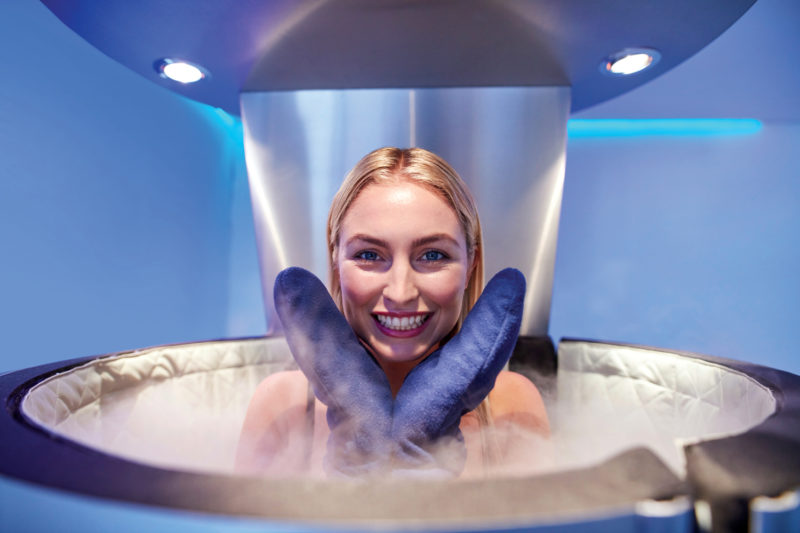
The listed advantages of cryotherapy make it possible for its widest application in medical practice.
Depending on how large a portion of the body is exposed to the refrigerant, local and general cryotherapy are distinguished.
General cryotherapy is carried out in special chambers - cryosaunas. The essence of the procedure is that a person is immersed for several seconds in a layer of carbon dioxide and nitrogen, cooled to -100-140С. During this time, the upper layer of the skin, where the receptors are located, manages to cool, but the body as a whole does not experience hypothermia. Another option for general cryotherapy is a ten-minute air blow at a temperature of -30 ° C.
An interesting aspect of the short-term exposure to extremely low temperature is that it produces a powerful release of endorphins. As a result, there is not only anesthetic, but also a slight sedative effect against a background of moderate euphoria.
Local cryotherapy
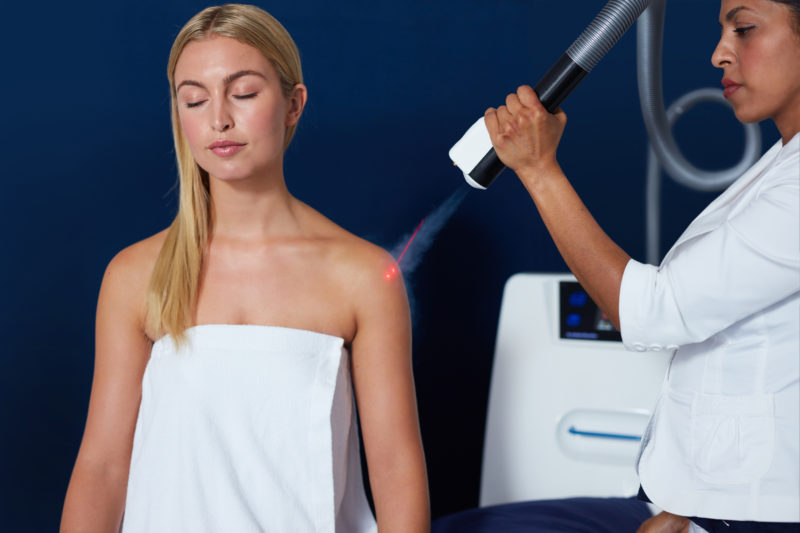
Local cryotherapy, in contrast to general cryotherapy, does not imply a complete immersion of the body in the refrigerant. Its essence is the rapid cooling of a small separate area of the skin or mucous membrane.
Local cryotherapy can be of two types:
- Non hardware. For procedures, water-containing solid refrigerants are used - ice cubes or synthetic cryobags. They are used for massage or applications. The temperature of ice is never lower than -7-10С, and depending on the diagnosis and the place of exposure, it can be delayed on the body for up to 30 minutes. Cryopackages are usually colder - their operating temperature reaches -20C. Therefore, impose them necessarily through a napkin and hold for 10-20 minutes.
- Hardware The procedures are carried out with the help of installations that supply cooling gas or dry cold air to the desired area of the body. Carbon dioxide, chloroethyl or liquid nitrogen are used as cooling gases. Their temperature can reach -180C. Exposure to such extreme temperatures is limited to seconds.
Read also: lymphatic drainage body massage
Local cryotherapy methods are widely used in the practice of treating dental, ENT diseases, as well as in cosmetology.
Cryotherapy of tonsils and adenoids
According to medical statistics, about 10% of the adult population in Russia suffers from chronic tonsillitis, a disease in which persistent inflammation of the palatine tonsils develops. Among children, these figures are even higher - 15%. A more depressing picture is observed in the incidence of chronic adenoiditis, it is detected in 20% of children.
Both diseases cause a lot of problems, the main of which is frequent SARS due to a persistent decrease in immunity. Patients with chronic tonsillitis and adenoiditis suffer from constant rhinitis, tonsillitis, children may develop hearing loss and other disorders.
Often, such patients are prescribed a radical method of treatment - surgical removal of tonsils or adenoids. However, this is a very painful operation, coupled with a long rehabilitation period.Cryotherapy of adenoids and tonsils can be an ideal alternative to surgery.
Cold treatment of tonsils and adenoids is called cryodestruction.
The advantages of this method are as follows:
- low invasiveness and bloodlessness;
- absence of damage to healthy tissues, due to which
- immunological activity;
- improvement of microcirculation and innervation of surrounding tissues;
- lack of postoperative scars.
The peculiarity of cryotherapy is that it allows not to remove the tonsils, but to cure them. As a result, the pathological process stops, but the lymphoid tissue continues to fulfill its protective function.
Cryotherapy of the nose (ENT diseases)
Cold therapy helps to cope with other diseases of the ENT organs. In particular, a well-developed technique for the treatment of the common cold - both the usual catarrhal and allergic forms.
Despite the apparent frivolity, all types of rhinitis significantly reduce the quality of life.
Acquiring a chronic nature, they entail a number of dangerous consequences:
- development of sinusitis;
- the development of inflammatory processes in the Eustachian tube;
- the formation of polyps;
- fibrosis of the mucous membrane and its complete atrophy.
Cryotherapy allows you to stop the pathological process. The procedure is painless, bloodless, performed on an outpatient basis and takes a total of about half an hour.
Throat cryotherapy
Among the diseases of the throat, one of the first places belongs to pharyngitis - inflammation of the mucous membrane. The disease develops either against the background of respiratory infections, or as a result of the action of irritants - gases, polluted air, chemicals. Often pharyngitis provokes opportunistic fungi that cause candidiasis (thrush).
In all cases, pharyngitis causes a lot of inconvenience, even if it is not accompanied by an increase in temperature. Local exposure to refrigerant on the lateral ridges of the posterior pharyngeal wall eliminates the focus of inflammation and stops the growth of pathogenic flora in the throat.
Within a few hours after the procedure, the patient may feel pain, but it disappears after the edema disappears. For a complete cure, 2-3 sessions may be required.
Facial Cryotherapy
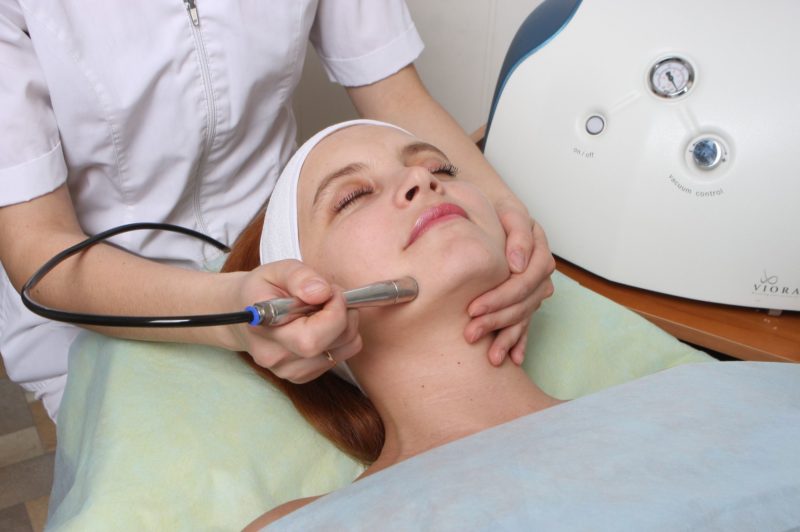
The use of cold for cosmetic purposes has become standard practice today.
Local cryotherapy in cosmetology is used as part of the following salon procedures:
- Cryomassage of the face. It is carried out either by ice cubes, or by a wooden applicator with liquid nitrogen. Increases skin tone, relieves swelling, eliminates pigmentation and rashes, treats acne.
- Cryodermabrasion. It polishes the skin with liquid nitrogen, smoothes the scarred tissue, removes stretch marks, and eliminates post-acne.
- Cryoelectrophoresis The procedure, which allows you to introduce frozen drugs into the deeper layers of the skin, improves skin tone, reduces wrinkles, treats acne, seborrhea, and improves blood microcirculation.
Facial cryotherapy involves treating skin problems in several approaches. As a rule, 3-5 sessions are required to achieve the effect.
Cryotherapy for hair
The problems of the scalp are also eliminated with the help of low-temperature media.
Cryotherapy in this case is indicated in the following cases:
- oily seborrhea with profuse dandruff;
- alopecia (hair loss).
During a cryotherapy session, liquid nitrogen is applied to problem areas using an applicator. As a result, blood supply improves, "dormant" follicles wake up, sebum secretion normalizes, pathogenic microorganisms that affect hair condition are destroyed.
Cryotherapy of papillomas and warts
Cryotherapy with liquid nitrogen of warts and papillomas is a procedure long mastered by cosmetologists. This is not the most progressive method, but is still very popular.
Cryodestruction of papillomas lasts about 2 minutes. Everything happens painlessly, the point effect of the refrigerant is felt only as tingling.Over the next 3 weeks, the abnormal tissue dies, becoming covered with a scab. After 1.5 months, the scab is rejected, and under it forms a healthy clean skin.
The problem with removing warts and papillomas with nitrogen is that the symptom is eliminated, but not the cause.
These formations on the skin are caused by the presence of the human papillomavirus in the blood. To get rid of warts, you must definitely undergo treatment for HPV.
Mole cryotherapy
Removal of moles (nevus) occurs similarly to the removal of warts - using liquid nitrogen. In this case, the doctor must first examine the formation and make sure that it is not malignant.
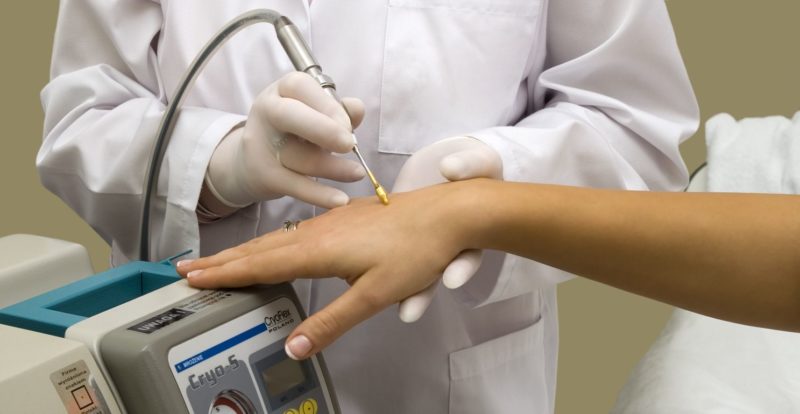
If the mole is deployed superficially, a cotton swab dipped in liquid nitrogen is simply applied to it. The exposure time is about 3 minutes. If the nevus is deep, intradermal, the refrigerant is supplied with a special tool - a cryodestructor.
It is interesting: nevus what is it
Before removing a mole, you must go to a consultation with an oncologist.
Very often, cryodestruction for the removal of nevi is not recommended, as it leaves no room for histological examination of tissues.
Procedure

The breadth of the areas of application of cryotherapy is such that there is no need to talk about any single course of procedures. For each case, its own methodology has been developed.
We can only highlight a number of general principles:
- before cryotherapy of the nose and throat, oral sanitation is performed to prevent tissue infection;
- the area that is exposed to cold is treated with an anesthetic - usually a 10% solution of lidocaine;
- Using a special tool or apparatus, the area is exposed to a cold agent for several seconds.
Thus, the local cryotherapy procedure consists of three stages: surface sanitation, anesthesia, and freezing. Hospitalization is not required.
Efficiency
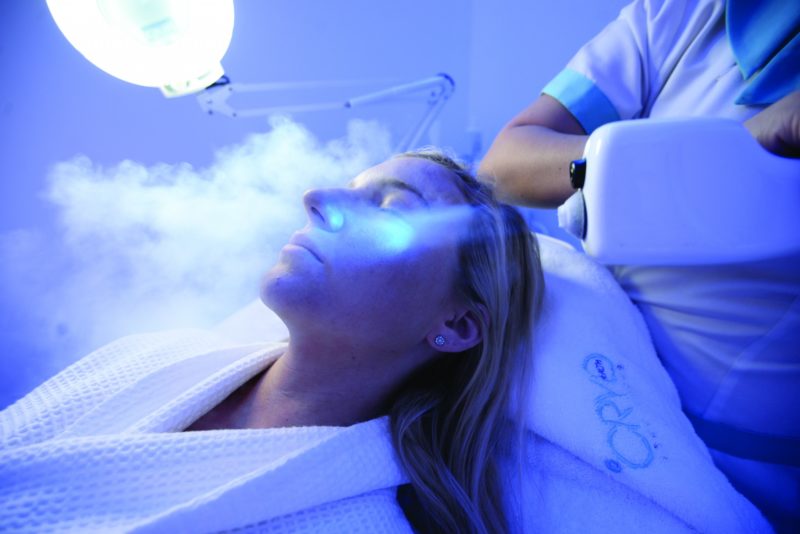
Monitoring reviews shows that patients who underwent cryotherapy for various reasons remain satisfied with the result. The procedures are easy to carry and do not cause complications. There are complaints of pain in the nasopharynx and nasal congestion after cryodestruction of the tonsils and adenoids, but after the edema subsides, the condition normalizes.
Persistent remission of ENT diseases after undergoing cryotherapy occurs in 100% of cases.
High efficiency is also confirmed by women who have tested cryotherapy methods in beauty salons. The effectiveness of the cryosauna against fat deposits and cellulite is especially emphasized. The only drawback of these procedures is the high cost.
How much is cryotherapy
To date, cryotherapy is a medical service provided on a paid basis. Its cost depends on the region and the clinic. On average, the price per session ranges from the following values:
| Procedure | Average price for 1 session |
|---|---|
| Cryodestruction of adenoid vegetation in children according to the Dragonfly method | 5800-8000 rubles |
| Palatine tonsil cryotherapy | 1000-2900 rubles |
| Cryodestruction of palatine tonsils | 2600-6900 rubles |
| Pharyngitis Cryotherapy | 1200-1500 rubles |
| Rhinitis Cryotherapy | 1000-1500 rubles |
| Cryomassage of the face | 900-1500 rubles |
| Cryotherapy of the scalp | 800-1000 rubles |
| Cryodestruction of warts and papillomas | 300-800 rubles |
| Cryodestruction of moles | 500-1000 rubles |
| Cryosauna of all zones | 1500-2000 rubles |
Cosmetic cryotherapy at home is also possible. Having prepared ice cubes with cucumber, aloe, lemon or cranberry juice, you can master the method of cryomassage of the face and neck and reduce the cost of going to the beauty salon.
It is important to observe precautions so as not to get frostbite on the skin.
In some mild cases, warts and papillomas can be removed at home. Now on sale there are drugs "Cryopharma" and "Wartner Cryo." They use a mixture of dimethyl ether and propane as a refrigerant, which must be applied to the formation using a sponge applicator.Drug developers guarantee desquamation of warts in 10-14 days.
Contraindications

Before using cryotherapy methods to correct health problems, you need to familiarize yourself with the contraindications to this procedure:
- peripheral circulatory disorders;
- a history of myocardial infarction and other heart diseases;
- obliterating endarteritis;
- Raynaud's disease;
- sickle cell anemia;
- intolerance to cold.
If there are implants in the tissues that change their physical properties at lower temperatures, you should notify your doctor.
With caution, cryotherapy is used to treat the elderly, since the thermoregulation functions in them have their own characteristics. For the same reason, cold treatment is contraindicated in children under 5 years of age. In all other cases, cryotherapy can be an effective tool for other medical methods and techniques.


